
We found Reykjavik and Iceland to have both some surprising culinary delights, as well as a certain repetitive monotony. This post will highlight our favorite dishes and restaurants, as well as culinary and related observations. Having now spent nearly a month in Iceland (two 2 week trips, 3 years apart, divided between week-long stays in Reykjavik and exploration of southern Iceland), we can say with some authority now that we have our favorites, which have stood the test of sampling over time.
Our favorite “every night” restaurant in Reykjavik is…an Indian restaurant! We loved Astur Indiafjelagid SO much, we ate there 3 times our first trip (spread over 2 weeks), and twice in 1 week on our recent trip. Our partner Rebecca went there last year on our recommendation and liked it so much she tremendously overate, almost to the point of disastrous consequences! The restaurant turned 20 this year, and is the fruit of an Icelandic-Indian marriage between proprietors Gunnar and Chandrika Gunnarsson. With chefs hailing from all over India, it offers a delectable variety of influences. From my journal from our 2011 trip: “The tandoori lobster appetizer, lamb in a mild curry, tandoori salmon and naan were so terrific that we made reservations for dinner for our final night in Iceland one week hence.” Returning 3 years later, we found the dining room doubled in size, and elegantly appointed. After 3 years of anticipation, it did not disappoint, combining intense Indian spices with superior lamb and seafood sourced from Iceland, a winning combination. We again sampled the menu liberally, beginning with an appetizer new to us, Subz Ki Galouti, a savory vegetable patty. The chicken with creamed spinach (murg saag), lamb curry, and Hariyali salmon tandoori were heavenly. The memory of the masala kulcha (naan) with cumin, onion, sesame seeds and coriander makes my mouth water as I type this. My only regret…not having had enough time to work our way completely through the menu.
Our favorite “special occasion” restaurant in Reykjavik is a name well known in foodie circles: Dill. Aka the NOMA of Reykjavik, it was superb 3 years ago at the Nordic Center and remains exemplary now in its new home downtown. I can only agree with a Trip Advisor reviewer who dubbed it Dill-ightfully Dill-icious. The new Nordic cuisine of Gunnar Karl Gíslason is superb. We had loved this restaurant on our prior stay, when it was housed in the Alvar Aalto designed Nordic cultural center, built to foster cultural relationships among the Nordic countries.
The first trip, we were so enthralled by a lunch of salad and an exceptional version of the ubiquitous fish soup that we immediately booked for dinner the following night. That location was lovely, a landmark of Scandinavian mid-century modern design, with a serene view across a large pond backed by the Reykjavik skyline. The new location, in downtown Reykjavik is more central, and lovely in a rustic way.
We opted for the 5 course dinner (vs. 3 or 7 courses, with or without wine pairings). The courses started after a series of superb bites, which were like culinary haiku.
The wine pairings included one course with a beer, and were unusual and inventive. The tariff was stiff but in line with gastronomic meals of this caliber ($85 per person for the 5 course option, wine pairings $85 additional per person). We were also introduced to a new spirit, the product of Foss Distillery, a collaboration between Dill’s chef and sommelier, Ólafur Örn Ólafsson. Seeking to capture the essence of Iceland in a bottle, they make use of birch, “the signature tree of Iceland.” We all loved the sweet liqueur, Björk (Icelandic for birch), served simply over ice and tonic water, enough to stock up at the duty free shop in Keflavik on our way home. (Sadly, we only bought one bottle, which we are making our way through in record time. Guess we’ll have to plan a restocking trip.)
But hold on, isn’t Iceland the country with no trees? It hasn’t always been that way. A 12th century text describes Iceland as “forested from mountain to sea shore”. The arrival of the Vikings upset a delicate ecosystem, with over-foresting, overgrazing by introduced sheep, volcanic activity, and glacier movement all contributing to soil erosion, greatly reducing the groves of native birch tress. The grove from which Foss Distillery harvests trimmings sustainably was planted in the 1960s at the foot of Haukafell mountain next to Vatnajökull glacier.
Back to the meal at Dill! Even before ordering, we had a series of 5 mini-courses, each just a bite, a showcase for the virtuosity of the chef. The presentations were simple, but elegant. We started with “carmelized scallop and malt spring” (pictured). The scallop was reduced to a wafer, transformed alchemically into something we could only describe as “the world’s best chip.” That is, savory and crispy, not literally like a potato chip, but we often found ourselves marveling without being able to really articulate what we were tasting. The “crispy potatoes and herb cream” were served on a stone, the potatoes formed into a miniature bird’s nest of fried stringed potatoes, filled with a puff of flavorful filling. Some of the mini-amuses featured exotic sounding ingredients, such as smoked deer hearts, at which we could never have guessed without having the menu at the ready.
The courses themselves were fantastic, more straight-forward and easier to understand, but with unique twists. The tomato salad was adorned with buttermilk and horseradish. Our fish dish of halibut made use of eggs, seaweed and angelica, a locally grown herb we remembered from our prior Dill meal, where it grew on the grounds of the Nordic House and could be seen through the windows around the pond.
Another course featured the “dark and oily” meat of common murre (a seabird, also found in California) from Grimsey, an island off north Iceland.
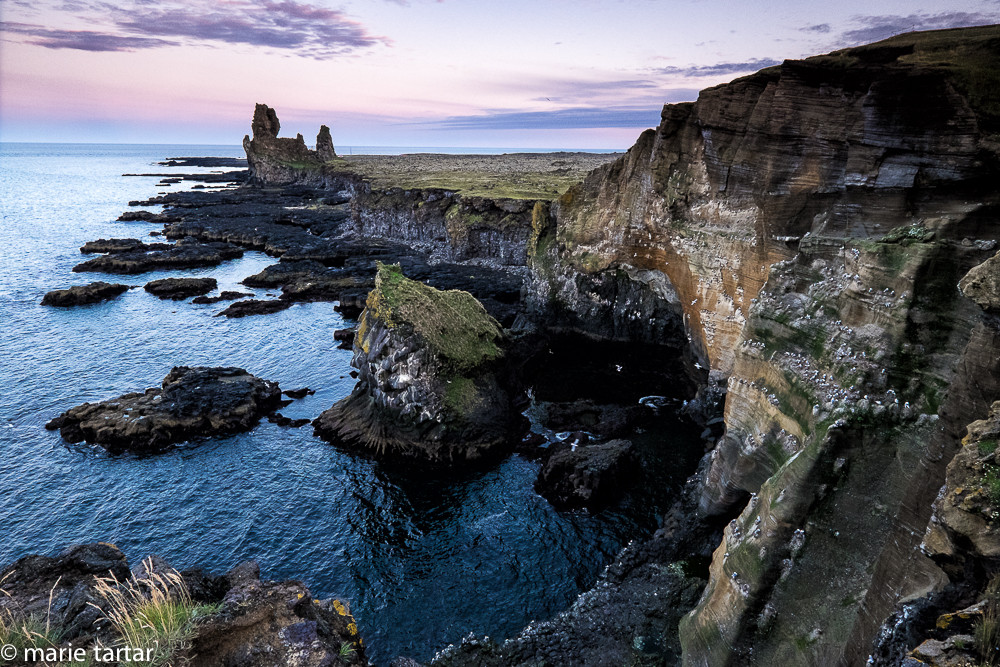
Seabirds are plentiful in Iceland; all those white spots are mostly seagulls (Snaefellsnes peninsula)
Dill was the gastronomic highlight of both trips to Iceland, closely followed by the Indian sub-continental delights of Astur Indiafjelagid. We did have other good meals, enjoying lunch on both trips at the counter of the colorful, book-lined Laundromat Cafe (which does have a child’s play area and laundromat downstairs).
The mango-mint drink is delicious and refreshing, and the orange-ginger soup substantial and savory.
Gastronomic highlights were more sparse outside of Reykjavik, but there were some memorable meals. Both trips, we thoroughly enjoyed staying at the Hotel Budir on the Snaefellsnes peninsula, and enjoyed leisurely dinners in their minimalist Scandinavian chic dining room. This trip, Steve and I dined on fresh pan-fried cod with cauliflower florets and sweet potato purée (Steve) and shellfish soup , a lobster appetizer and salad for me, all washed down with the house white, an aromatic Trapiche Argentinian chardonnay. On our return visit this trip, after camping 2 nights at Arnastapi, the men elected the lamb shank, while I had the monkfish, accompanied by barley, which appears as a side with some regularity in Icelandic dining rooms. The langostine appetizer was set off well by the Trapiche Argentine chardonney we had previously enjoyed, with their Malbec accompanying the lamb well.
Langostine, the small, sweet and delicious local version of lobster, appeared in multiple guises, sometimes as the center of attention, other times as a garnish to a pizza. One of the best unadorned versions was in one of the less likely locales, at the simple Guesthouse Gerdi, where we camped on their lawn for a couple of nights, while the overtaxed staff strained to keep up with the busloads of guests appearing daily. Our guide, Chris, arranged this for our last night there. We had to wait until the nightly buffet furor died down, but it was well worth the wait.
Langostine also was marvelous as a tandoori grilled appetizer at Astur Indiafjelagid, as the main attraction in Gummi’s lobster salad at the Seafood Grill (Sjavargrillid ), and in a recurring role as a pizza ingredient, as in the langostine and pesto pizza at the airport restaurant, Nord, endorsed by our check in agent at Iceland Air as her favorite in the airport. The most unlikely sounding but actually quite tasty pizza combination was arctic char (trout, with salmon-colored flesh) with banana and olives, on the snacks menu of the Icelandair Hotel Klauster in Kirkjubaejarklaustur.
Carrot-ginger soup was the star of the menu for me at Esjustofa Hiking Centre and Bistro, conveniently located 15-20 minutes from Reykjavik, en route to the Snaefellsnes peninsula. Their version of the ubiquitous Icelandic lamb stew was satisfying as well.
Three years ago, I virtually lived on this staple menu offering, staying as we were in Husafell, where the Husafell Cafe was really the only show in town. Thankfully, I really liked their savory stew, as I had it 3 days in a row! From my journal of our 2011 stay; “We had a pleasant surprise with the café. My Icelandic meat (lamb) soup with cabbage and root vegetables was savory, hearty and delicious, and Steve’s lamb sandwich with onion chutney and apple cake was satisfying as well. The café being a cut above was a welcome discovery, as the mini-market next door didn’t seem to be too encouraging in terms of cooking for ourselves. It did have frozen hotdogs, minimal produce and was generally uninspiring”.
Speaking of hotdogs, they are an Icelandic favorite. We did try the “with everything” version from the most famous of these stands, Bæjarins Beztu Pylsur (reportedly means “the best hot dogs in town”), down by the Harbor, habituated by the likes of Bill Clinton and other notables when in Reykjavik. Diplomatically speaking, I can say it sufficed to satisfy any hotdog craving I have for the foreseeable future (this only crops up every 10 years or so), but I wouldn’t consider it a destination hotdog. At home, I learned that Icelandic hotdogs have some lamb in them, in addition to the customary pork and beef.
Rhubarb is a tart vegetable (not fruit, I just learned!) I love, which cropped up at interesting intervals. The crimson stalks were a featured ingredient in our dessert at Dill, along with omnom and burned butter, and really enlivened and gave a local slant to a mojito at the restaurant at Leirubakki, an old manor farm. You may be wondering what is omnom, as I did when I re-read my saved menu #127 from Dill and had to google it (repeatedly). The best I can figure…it’s short for om nom nom, or the muffled sounds of someone, say the Cookie Monster, moaning with pleasure as they wolf down, say, dessert, perhaps a cookie. As this was our 5th course and 6th alcoholic accompaniment, I trust I can be forgiven for not noticing this in-joke until weeks afterward, when I was writing this. Or maybe the joke’s on me, and omnom actually is some refined Icelandic ingredient.
As for the restaurant at Leirubakki, I had noticed this interesting contemporary structure on our way into the Interior ( Landmannalaugar), partially below grade with a living meadow roof, which proved to be our dinner stop on our return. The friendly blond waitress was delighted at our interest in the structure and explained that the architect was a local daughter (Hledis Sveinsdottír) who grew up in the adjacent house, and now worked with a firm named Eon (EON arkitektar). The current hotel and restaurant occupied the same footprint as a former barn. She pointed out subtle elements, such as the spanning concrete beams varying in inflection point across the width of the room. The large dining room window wall was at meadow level, with the grasses whipping with the wind, and Hekla the volcano clinging to a slight cloud veil.
As for the monotony, even our Icelandic guide Chris, complained that outside of Reykjavik, the same items appear on every menu: lamb soup/stew, seafood soup (usually fish, less often langostine), hamburgers, and pizza. We had some opportunities to sample some of the traditional (notorious?) foods of Iceland, but mostly declined. Our arrival at the BSI bus terminal in Reykjavik apparently would have been the ideal place to have sampled to have sampled sheep’s head. I found this Trip Advisor posting amusing:
“I can’t say it was atmospheric or the food was delicious (by my British tastes), but I will say – go! Go because you can order the Sheep’s Head. The head is chopped in two, and served on a plate with mash and suede. It’s intact with tongue (if you’re lucky – it’s the best bit, we were told), skin and eye. I popped the eye out and shared it with my equally bemused friend…oh and have a beer ready, you’ll need it. ” Chris’ description of its preparation (singed, then boiled) and his curled lip made us think we hadn’t missed too much.
We could have sampled whale at the Seafood Grill, but…whale? Ugh, I don’t think so. In fact, the fact that commercial whaling is still legal and practiced in Iceland is one of the few things I really intensely DISLIKE about Iceland (the only other 2 countries being Norway and Japan). I learned a lot of interesting facts while researching this piece from the WDC (Whale and Dolphin Conservation) website. The targeted species are the endangered fin whale, which is mostly shipped to Japan, and the minke whale. Sadly, the minke whale meat trade seems to be driven by the market catering to deluded tourists desiring to sample “traditional” Icelandic foods. Per the WDC site, only 3% of Icelanders eat whale meat on a regular basis, so this certainly isn’t a current culinary practice of Icelanders. I can’t agree more with the position of the WDC:
If you are traveling to Iceland or Norway this year, please be aware that whale meat consumption by tourists, often in the mistaken belief that the practice is ‘traditional’, is helping to keep this barbaric industry alive. Please urge friends, relatives and work colleagues not to put money into the pockets of the whalers.
I did sample a small amount of smoked puffin meat (I didn’t order it, it was part of a buffet), and won’t be craving that.
A very dark meat and a very adorable bird, it is more of an acceptable fixture in the Icelandic diet, but for me, I’ll make do with yet another bowl of the ubiquitous Icelandic lamb soup…
-Marie
To summarize:
Our Reykjavik favorites: Astur Indiafjelagid (Indian), Dill (New Nordic cuisine), Laudromat Cafe (casual, good for lunch)
Other good Reykjavik options: Seafood Grill, Fish Market (please boycott whale options on their menus)
Snaefellsnes Peninsula: Hotel Budir (www.budir.is), (Hellnar, nice outdoor deck), Hotel Rjúkandi
Resources:
Dill: Hverfisgata 12, 101 Reykjavík, Iceland
Austur-Indíafjelagid: Hverfisgotu 56, www.asturindia.is, (354) 552 1630
Esjustofa Hiking Centre and Bistro, Mógilsá, 111 Reykjavik, 354 565 3200, 10-18 hours daily
Hotel Leirubakki and Hekla Center, Leirubakki, 851 Hella, www.leirubakki.is, 354 4878700
; 356, Snæfellsbær; fjoruhusid@isl.is ; 354 435-6844
Hotel Rjúkandi, Vegamót, Snæfellsnes, 311 Borgarnes – Iceland; 354 435 6690

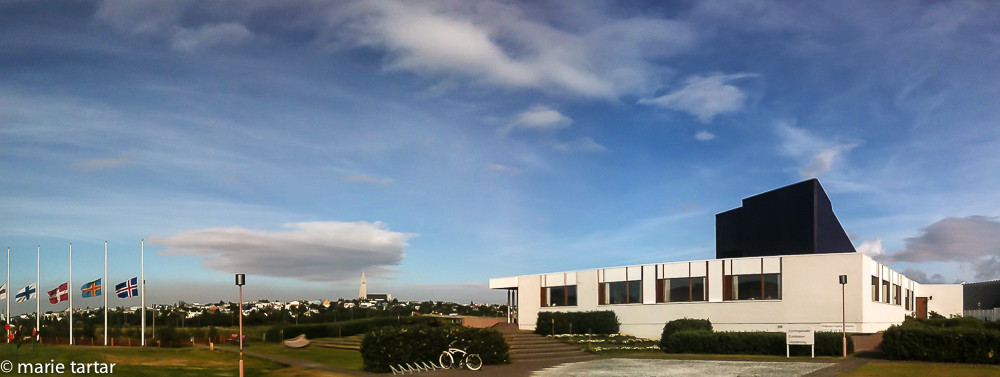
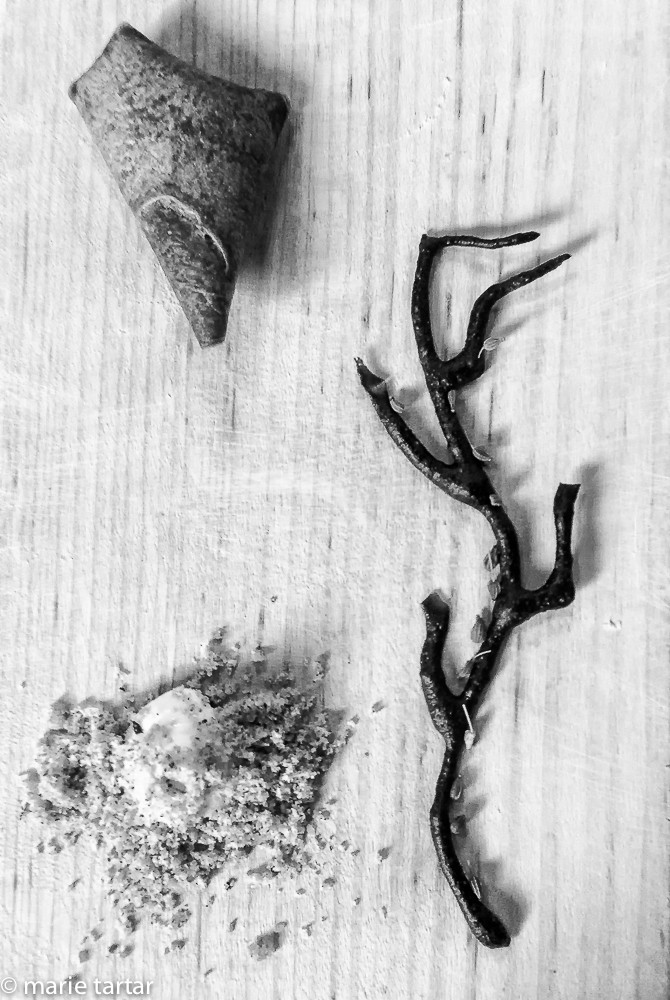


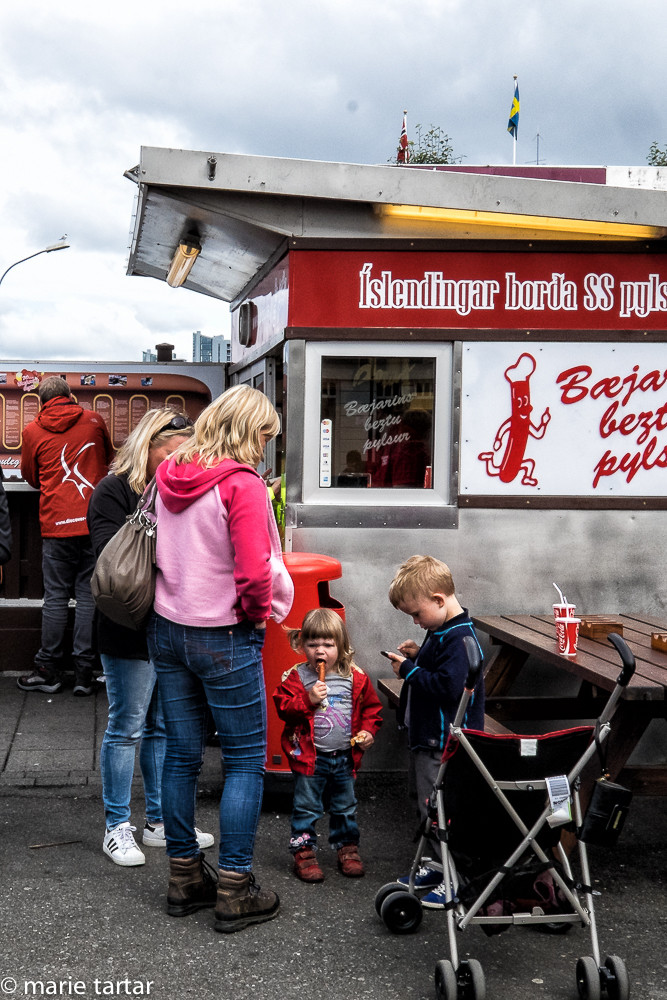
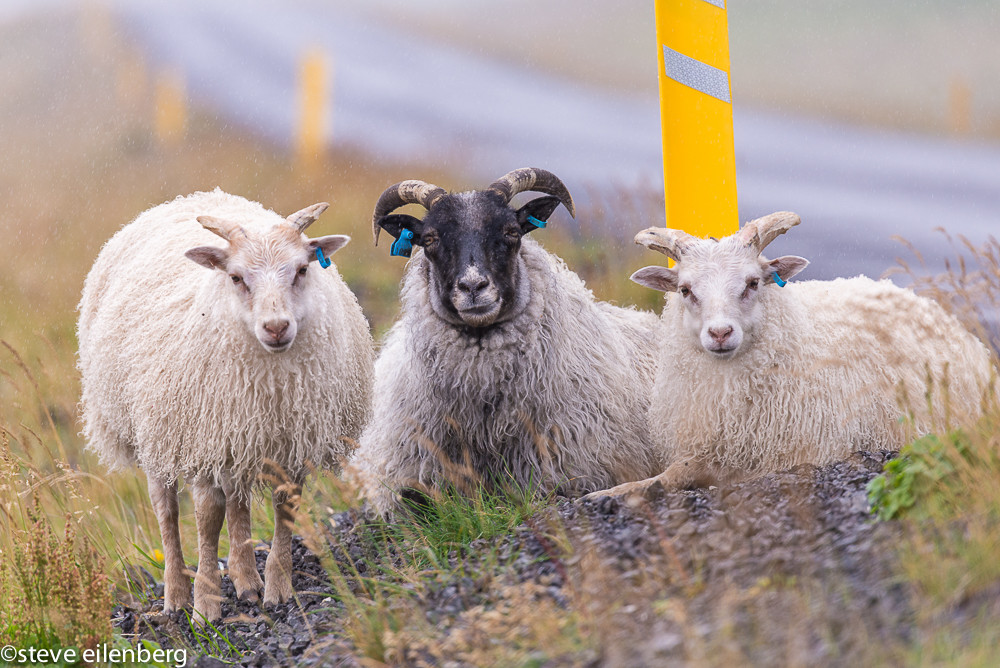

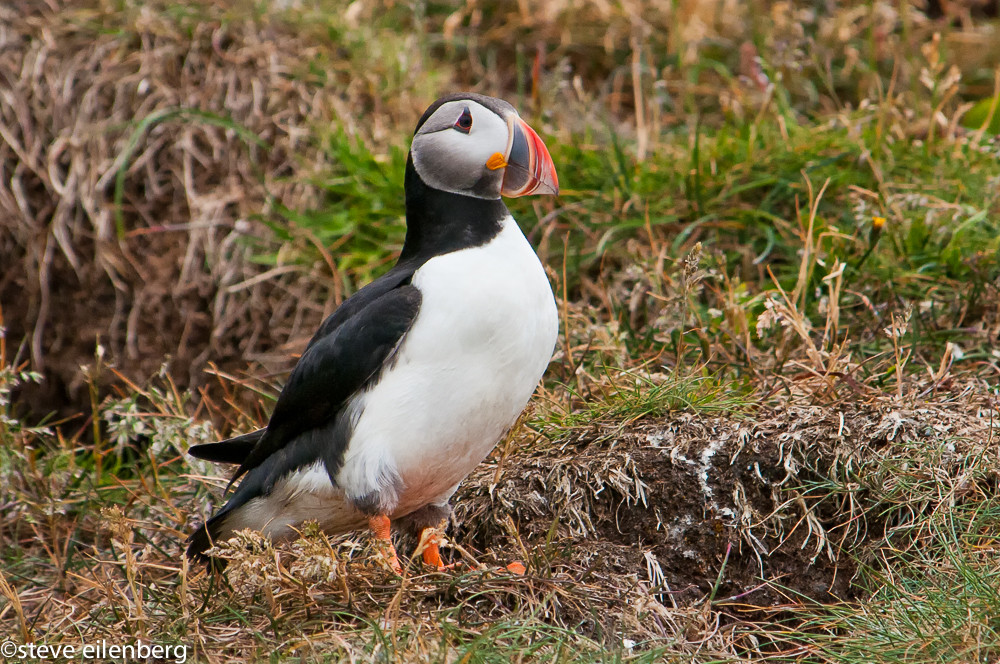
I should never have read this on an empty stomach; it was a feast for the eye and stomach, omnom!
looking forward to some om non nomming with you in guanajuato!
looking forward to our next meal at Dill…maybe for the northern lights!
sounds like a great combo!
In Danish, the way one articulates a lip smacking delight was the nonsense phrase “nama nama”.
Every paragraph made me remember that. You are awakening a willingness to endure long and painful air travel…
food for thought, richard, you can stop off for up to 7 days without penalty (coming or going) in iceland if you travel to europe on iceland air!
I love your crazy looking little hotdog eater. Her intensity, her hair style, little face and preferring dog to bun.
me too! i didn’t find the hotdogs that enticing myself!
Um…oops! I tried whale when I was in Iceland (and puffin!) but will definitely think twice next time I see it on the menu. Thanks for the shout out!! 😉